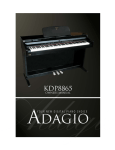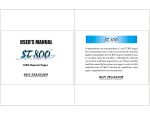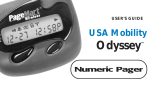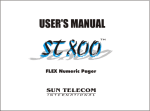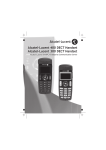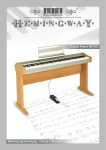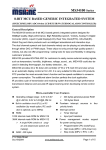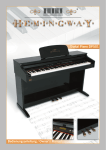Download Williams Etude Specifications
Transcript
Thank you for purchasing this digital piano. For optimal operation and security, please read this manual carefully and keep it for future reference. Safety Precautions The lightning flash with arrowhead symbol within an equilateral triangle is intended to alert the user to the presence of un-insulated dangerous voltage within the product’s enclosure that may be of sufficient magnitude to constitute a risk of electric shock to people. The exclamation point within an equilateral triangle is intended to alert the user to the presence of important operating and maintenance (servicing) instructions in the literature accompanying the product. Important Safety Instructions 1. 2. 3. 4. 5. 6. 7. 8. 9. 10. 11. 12. 13. 14. Read these instructions. Keep these instructions. Heed all warnings. Follow all instructions. Do not use this instrument near water. Figure 1 Clean only with dry cloth. Do not block any ventilation openings; install in accordance with the manufacturer’s instructions. Do not install near any heat sources such as radiators, thermostats, stoves, or other apparatus (including amplifiers) that produce heat. If the provided plug does not fit into your outlet, consult your dealer or an electrician for replacement of the obsolete outlet. Protect the power cord from being walked on or pinched particularly at plugs, convenience receptacles, and the point where they exit from the instrument. Only use attachments/accessories specified by the manufacturer. Use only with the cart, stand, tripod, bracket, or table specified by the manufacturer, or sold with the instrument. When a cart is used, use caution when moving the cart/instrument combination to avoid injury from tip-over (Figure 1). Unplug this instrument during lightning storms or when unused for a long period of time. Refer all servicing to qualified service personnel. Servicing is required when the instrument has been damaged in any way, such as when the power-supply cord or plug is damaged, liquid has been spilled or objects have fallen into the instrument, the instrument has been exposed to rain or moisture, does not operate normally, or has been dropped. WARNING: To reduce the risk of fire or electric shock, do not expose this instrument to rain or moisture. CAUTION: This instrument should not be exposed to dripping or splashing and objects filled with liquids, such as vases, should not be placed on the instrument. Thank you for choosing the Williams Etude digital piano Your Williams Etude is a high-quality digital piano with an 88-note touch sensitive keyboard that uses the most advanced PCM tone generation technology. Your instrument has 8 demo songs which can be selected to play back. The realtime recording function allows you to play back whatever you have recorded. For maximum performance and enjoyment, please refer to this manual while trying out the various features described. Contents Control Panel 1 Playing the Piano Turning on Power Setting Volume Using Headphones Using an External Sound System Sustain Pedals Selecting a Voice Selecting Dual Voice Mode Reverb Effect Chorus Effect Touch Sensitivity Metronome Recording Playback Demo 2 2 2 2 3 3 3 4 4 4 5 5 6 6 MIDI Control Specifications Assembly Instructions 7 8 9 MULTI DISPLAY 10 VOICE Selectors 11 RECORDER [PLAY] and [REC] Buttons 12 MIDI OUT/IN Connectors 4 CHORUS Button 5 TOUCH Button 6 DEMO Button 9 9 8 METRONOME Button 7 3 REVERB Button 6 TEMPO Buttons 5 8 4 15 16 2 MASTER VOLUME Control 3 13 14 7 2 12 1 Power ON 1 TOP PANEL BACK PANEL 16 DC 12V Jack 15 Phone Jack 14 Line Out Jack 13 Sustain Pedal Jack 10 11 Playing the Piano Turning on the Power Before playing, turn the power on by pressing the POWER switch. The panel LED will light. Setting the Volume Initially set the MAIN VOLUME about half way between the “MIN” and “MAX” settings. You can adjust the volume to accommodate the way you play. Using the Headphones A standard pair of stereo headphones can be plugged into the PHONE jack for private practice or late-night playing. The internal speaker system will automatically shut off when a pair of headphones is plugged into the PHONE jack. Using an External Sound System The LINE OUT jack can be used to deliver the output of the piano to a keyboard amplifier, stereo sound system, mixing console or tape recorder. 2 The Sustain Pedal A footswitch can be plugged into the rear-panel SUSTAIN PEDAL jack. It functions similar to that of an acoustic piano. The Sustain Pedal functions as a damper pedal controlling sustain. Press the pedal to sustain notes after the keys are released. The Soft Pedal controls the sound volume. Press the pedal to decrease the output sound volume. Select a Voice There are eight voices embedded in the piano. They are a Studio Grand Piano, Concert Grand Piano, E.Piano1, E.Piano2, Harpsichord, Vibes, Strings, and Church Organ. By pressing the Voice button, you can select the desired Voice and its indicator will light up. Select Dual Voice Mode Press two voice buttons at the same time, and their indicators will light up. Two voices will sound simultaneously when you play the keyboard. 3 Reverb Effect The Reverb effect reproduces the natural ambient sound that occurs when an instrument is played in a room or concert hall. You can press the [REVERB] button several times to select REVERB type, and you can press the [REVERB] button to switch OFF the Reverb effect. All the REVERB indicators will not be lighted. Chorus Effect The Chorus effect can be turned on and off by pressing the [CHORUS] button. This effect lets you enhance the voice by making it sound fuller. Touch Sensitivity Press the [TOUCH] button, and you can select four types of touch sensitivity levels to accommodate your playing. The corresponding indicator will be lighted. HARD style: requires more strength to produce sound. MEDIUM style: requires standard strength to produce sound. SOFT style: requires less strength to produce sound. FIXED style: pressing the keyboard with more or less strength will produce the same sound volume. Press the [TOUCH] button several times until the indicator is not lit. Hold it for more than two seconds, and the sound volume will show on the LED. Use the [TEMPO+/-] buttons to adjust the sound volume. 4 Metronome Press the [METRONOME] button, to turn the metronome function on or off . When this function is on, you can select the tempo by pressing the [TEMPO+/-] buttons. Digital LED displays the metronome speed. Press the [TEMPO+/-] button to adjust the tempo speed from 32 to 280. Press the two buttons at the same time, and the tempo speed will return to 120. Time signatures include #1/4 time, 2/4 time, 3/4 time, 4/4 time, 6/4 time, 6/8 time, 12/8 time When you turn on the metronome, hold the [METRONOME] button and then press the [TEMPO+/-] button to select the time signature. Record Melody Track Record Press the [RECORD] button and then press [MELODY1] or [MELODY2] button to select the track to record on. Your Williams Etude has a 2 track recorder. If the other track has data recorded, it will play when recording is started. Recording is started once you press a key on the keyboard. Press the [RECORD] button again, and the recording will end. If you want to record the MELODY1 track: Press the [RECORD] button. Its indicator will light. Then press the [MELODY1] button, and its indicator will flash. The MELODY1 track is now ready to record. 5 Playback First press [MELODY1] or [MELODY2] to select the melody track you want to play, and then press the [PLAY] button. The song you have recorded will play back. When in the PLAY mode, pressing this button again will end this mode. Demo Press the [DEMO] button, and the eight voices LED will flash. These eight buttons represent 8 demo songs. Press the button and the corresponding song is selected. If you don’t select a song for 5 seconds, the first song will be played automatically. When in the demo mode, press this button again to terminate the status. 6 MIDI MIDI (Musical Instrument Digital Interface) is a world-standard communication interface that allows other MIDI-compatible instruments and equipment to transmit information and control one another. This makes it possible to create “systems” of MIDI instruments and equipment that offer far greater versatility and control than is available with isolated instruments. MIDI Connectors Your instrument MIDI IN connector receives MIDI data from an external MIDI device which can be used to control yours. The MIDI OUT connector transmits MIDI data generated by your instrument (e.g. note and velocity data produced by playing the keyboard). MIDI Control Most MIDI keyboards (including your instrument) transmit note and velocity (touch response) information via the MIDI OUT connector whenever a note is played on the keyboard. If the MIDI OUT connector is connected to the MIDI IN connector of a second keyboard (synthesizer, etc.), a tone generator will respond precisely to notes played on the original transmitting keyboard. The result is that you can effectively play two instruments at once, providing thick multi-instrument sounds. This instrument also transmits “program change” data when one of its voices is selected. Depending on how the receiving device is set up, the corresponding voice will be automatically selected on the receiving keyboard or tone generator whenever a voice is selected on your instrument. Your instrument is capable of receiving the same MIDI data, so a second MIDI keyboard connected to your instrument MIDI IN connector can be used to remotely play yours and select voices as required. 7 Specifications Keyboard Polyphony Voice Selectors Recorder Pedal Control Other Controls Jacks/Connectors Main Amplifiers Speakers Dimensions (WxDxH) Weight 88 Keys (A-1 ~C7) Four Types of Touch Sensitivity 64 Notes Max. S. G. Piano, Concert Grand Piano, E.Piano1, E.Piano2, Harpsichord, Vibes, Strings, Church Organ Record, Play, >3000 Notes Sustain Master Volume, Tempo, Touch, Metronome, Demo, Reverb, Chorus, Dual, MIDI Phone, Power, Line Out, Pedal, MIDI IN, MIDI OUT 40W X 2 (6.5 x 2 Inch), (2 x 2 Inch) Console: 58” x 23” x 11.4” Stand: 54.5” x 12” x 7” 123 lbs. 8
















